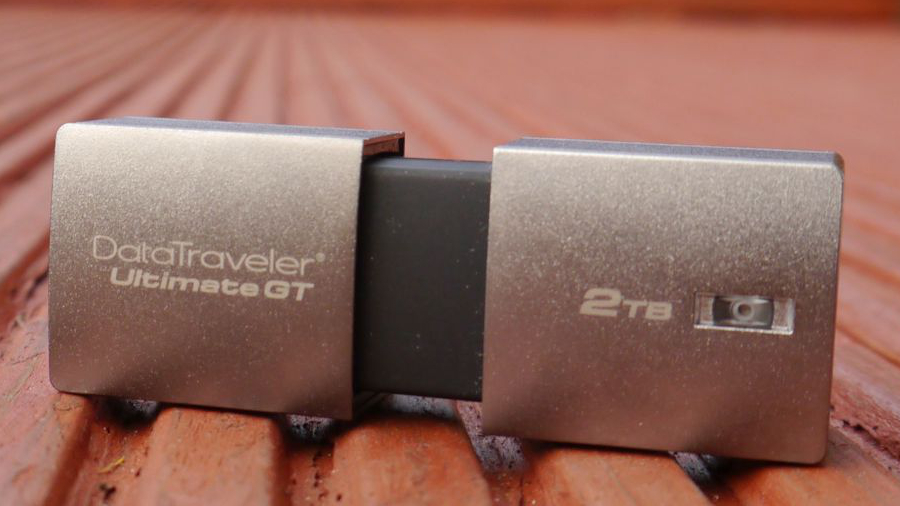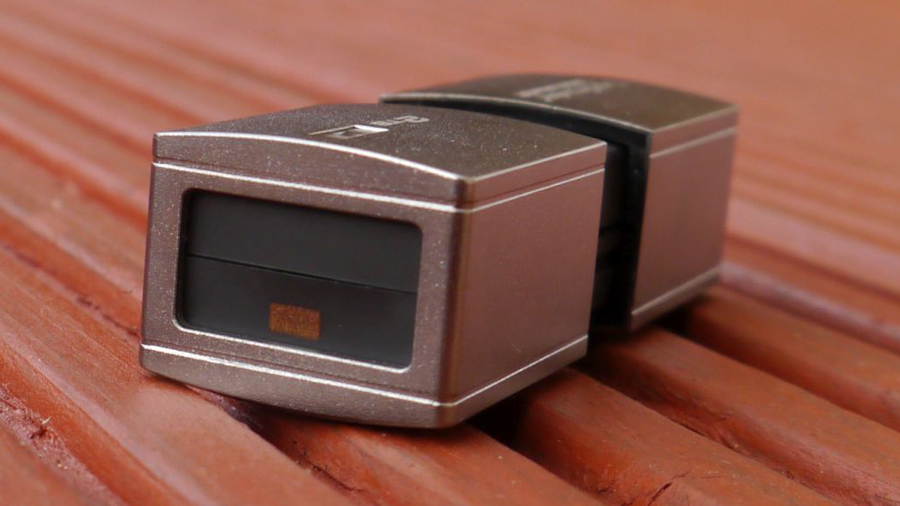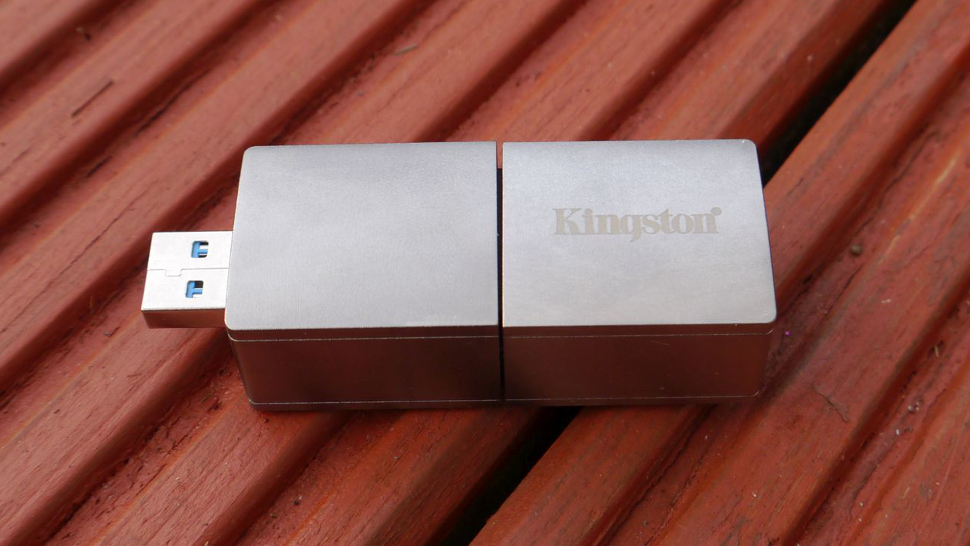Early Verdict
The DataTraveler 2TB flash drive certainly makes quite an impression, but unfortunately that’s mostly due to the price tag rather than its performance or indeed size. In short, it’s not a particularly compelling purchase.
Pros
- +
Compact size
- +
Five year warranty
Cons
- -
Very expensive
- -
Lacking in performance compared to rival tech
- -
It’s small, but overly thick
Why you can trust TechRadar
There was a time when USB flash drives were hailed as the saviour of a generation, riding to the rescue of the many folks who had been burned so many times by the unreliability of floppy disks (and their low capacity).
Memory sticks or thumb drives, as they are also referred to, made the venerable plastic magnetic disks obsolete almost overnight, and single-handedly started a race to cram even more data in per unit volume with decreasing costs.
That race has now cooled down and nearly two decades after the first USB sticks hit the market, the biggest of them all has landed with the intention of stirring things up again.
Meet the Kingston DataTraveler Ultimate GT, a memory stick with a gargantuan 2TB capacity, not to mention an equally massive price tag (£1,507 from Currys/PC World Business – that’s around $1,950, AU$2,650). That’s twice the capacity of the previous record holder, a 1TB drive launched in 2013 by the same manufacturer.

2TB is about a million times bigger than the capacity of the first flash drives. It’s enough to store 70 hours of 4K footage, and is an order of magnitude larger than what most laptops or smartphones can cope with.
However, the price per GB of the DataTraveler Ultimate GT is by far the most expensive on the market at just over 75p – about three times what you can expect to fork out for a large USB drive of similar performance but with a smaller capacity (e.g. this Integral 256GB drive).
2TB is also twice the capacity of the biggest SDXC cards that are available on the market, making this peripheral ideal if the user wants to carry around and use a universally accessible storage device with a minimum of fuss.
Sign up to the TechRadar Pro newsletter to get all the top news, opinion, features and guidance your business needs to succeed!

The Ultimate GT is bigger than expected at around the size of a pack of chewing gum, measuring 75 x 27 x 21mm and weighing just under 60 grams. It comes in a tin box complete with a cable converter and a small carry bag.
First off, let’s discuss a couple of points about the drive itself. It is solidly built thanks to a zinc alloy die-cast metal casing, and the connector can be hidden by pulling the two movable parts of the drive in opposite directions.

While the drive looks rugged, it is neither water-resistant nor certified as being shockproof (or indeed dustproof). Bear that in mind should durability be one of your prime concerns.
The cable gives the user more leeway to position the drive where they want and reduces the risk of accidental damage to the ports (and the drive).
That’s particularly important as this USB stick is so thick that it could lift an Ultrabook laptop off a desk surface, and might even block access to other ports. Not ideal.

The connector is a USB 3.1 Gen 1 port (aka USB 3.0) which allows transfer rates of up to 5Gbps and according to Kingston, should hit 300MBps in read and 200MBps in write speeds.
As expected, the Kingston DataTraveler Ultimate GT comes with a long warranty (five years) and is compatible with most recent operating systems (Windows, Linux, Mac and Chrome OS).
Surprisingly, unlike the Samsung T3, it is not compatible with the increasingly popular USB Type-C connector, and doesn’t come with any bundled applications (such as encryption tools or a backup suite, which you might well expect to get as bonuses on something this pricey).

The drive was exFAT formatted and reached 302MBps and 181MBps (read and write respectively) under CrystalDiskMark, achieving Kingston’s quoted speed in the former category, and coming close in the latter.
Under ATTO’s popular disk benchmark, the drive’s transfer rates hit 289MBps and 199MBps with read/write speeds respectively, again quite near to what the manufacturer has put forward as maximum theoretical numbers.
While these numbers are impressive for a USB flash drive, they are inferior to SSD storage drives, which although part of the same family, use a different technology which gives them a significant edge. Bear in mind, though, that the maximum performance will very much depend on the USB connectors both on the client device and the drive itself.

Early verdict
It is difficult to recommend the Kingston DataTraveler 2TB USB drive as a ‘must’ or even a ‘should buy’ given the colossal price. The end user is not only paying a very significant premium to get a higher data density, but most importantly, they’re paying extra to get an inferior product in terms of performance compared to other options on the market.
If size is not an issue but you want a storage device that’s fast and relatively affordable, then a standard 2.5-inch SSD in an enclosure will do the trick. Try the Samsung 850 Pro 2TB with an enclosure for about half the price.
If size is an issue but price isn’t, then the speedy Samsung T3 should be considered, especially with a 60% discount compared to the DataTraveler Ultimate GT – and better performance all round (up to twice as fast).
It also weighs less than Kingston’s drive and has a number of useful applications bundled, including a transparent hardware-based encryption solution which promises no degradation in performance.
For this USB drive to be reassessed in a more positive light, it will need to decrease in size (or at least be flattened) and most importantly, it will need to come down in price. At this point, though, Kingston engineers will need to hope that Samsung doesn’t unleash a smaller version of the T3 (the next iteration is due to come out soon).
- We’ve highlighted the best USB flash drives of 2017

Désiré has been musing and writing about technology during a career spanning four decades. He dabbled in website builders and web hosting when DHTML and frames were in vogue and started narrating about the impact of technology on society just before the start of the Y2K hysteria at the turn of the last millennium.
What is a hands on review?
Hands on reviews' are a journalist's first impressions of a piece of kit based on spending some time with it. It may be just a few moments, or a few hours. The important thing is we have been able to play with it ourselves and can give you some sense of what it's like to use, even if it's only an embryonic view. For more information, see TechRadar's Reviews Guarantee.
